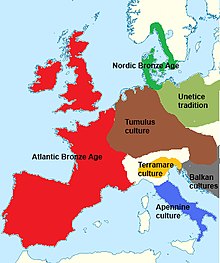
Back حضارة الأبينيني Arabic Cultura apenínica Catalan Apennin-Kultur German Cultura apenínica Spanish Culture apenninique French Cultura appenninica Italian 아펜니네 문화 Korean Apeninų kultūra Lithuanian Kultura apenińska Polish Апеннинская культура Russian
 Western Europe during the Middle Bronze Age: the Apennine culture is in blue, while the Terramare culture is in yellow | |
| Geographical range | Central Italy, South Italy |
|---|---|
| Period | Bronze Age |
| Dates | 15th-12th centuries BC |
| Preceded by | Grotta Nuova facies, Protoapennine facies, Bell Beaker culture |
| Followed by | Proto-Villanovan culture |
The Apennine culture is a technology complex in central and southern Italy from the Italian Middle Bronze Age (15th–14th centuries BC).[1] In the mid-20th century the Apennine was divided into Proto-, Early, Middle and Late sub- phases[1], but now archaeologists prefer to consider as "Apennine" only the ornamental pottery style of the later phase of Middle Bronze Age (BM3). This phase is preceded by the Grotta Nuova facies (central Italy) and by the Protoapennine B facies (southern Italy) and succeeded by the Subapennine facies of 13th-century ("Bronzo Recente"). Apennine pottery is a burnished ware incised with spirals, meanders and geometrical zones, filled with dots or transverse dashes. It has been found on Ischia island in association with LHII and LHIII pottery and on Lipari in association with LHIIIA pottery, which associations date it to the Late Bronze Age as it is defined in Greece and the Aegean.[2]
- ^ a b Coles, John M.; Harding, A. F. (1979). The bronze age in Europe: an introduction to the prehistory of Europe, c. 2000–700 BC (illustrated ed.). London: Taylor & Francis. p. 165. ISBN 978-0-416-70650-5.
- ^ Bury, J. B.; I E S Edwards; C. J. Gadd; John Boardman; N. G. L. Hammond (1975). P. Mack Crew (ed.). The Cambridge Ancient History: c. 1800–1380 B.C. Vol. II, part 2: c. 1380–1000 B.C. (3, revised ed.). Cambridge University Press. p. 720. ISBN 978-0-521-08691-2.
© MMXXIII Rich X Search. We shall prevail. All rights reserved. Rich X Search